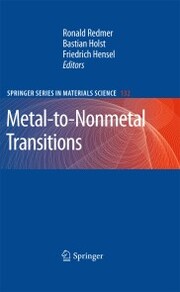Detailansicht
Metal-to-Nonmetal Transitions
eBook - Springer Series in Materials Science
ISBN/EAN: 9783642039539
Umbreit-Nr.: 1700697
Sprache:
Englisch
Umfang: 200 S., 4.85 MB
Format in cm:
Einband:
Keine Angabe
Erschienen am 10.03.2010
Auflage: 1/2010
E-Book
Format: PDF
DRM: Digitales Wasserzeichen
- Zusatztext
- Materialscanbedividedintometalsandnonmetals.Thecharacteristicfeature ofmetalslikecopperandaluminumisahighelectricalandthermalconduct- ity, while nonmetals such as phosphor and sulfur are insulators. The electrical 6 ?1 ?1 conductivity varies over many orders of magnitude, from 10 ? m for ?20 ?1 ?1 typical metals down to 10 ? m for almost ideal insulators. However, a sharp separation between metals and insulators is in general not possible. For instance, semiconducting materials such as silicon and germanium ?ll the conductivity domain between metals and insulators. Their electrical cond- tivity is dependent on temperature and,in addition, canbe variedstronglyby doping the material with donor or acceptor atoms. A famous example is the sharp insulator-to-metal transition measured in Si:P at temperatures below 18 ?3 0.1K and donor concentrations of about 3.8×10 cm phosphor atoms [1]. Furthermore, materials may exist in both states: carbon is metallic as graphite and insulating as diamond. A fascinating quantum e?ect is observed at low temperatures: some materials even loose their electrical resistivity and becomesuperconductors.Therefore,thequestionsWhatisametal?andWhen does a metal transform into a nonmetal? are of fundamental interest and - lated to many aspects of modern physics and chemistry. We refer the int- ested reader to the very nice introduction into this diverse topic given by Edwards [2].
- Kurztext
- <P>Metal-to-Nonmetal Transitions presents the current research in the field from both physical and chemical perspectives. Discussions of the macroscopic, microscopic and quantum aspects of these transitions make this a useful reference for researchers and students.</P>
